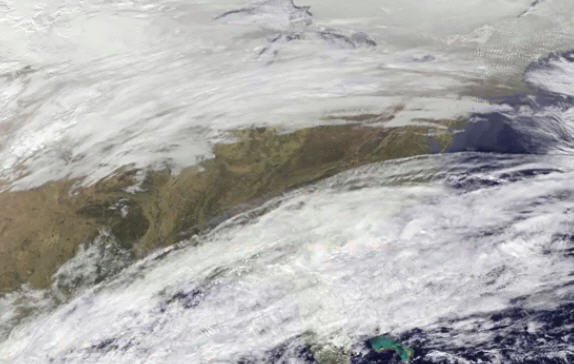Satellite Time-Lapse Movie Shows U.S. East Coast Snowy Winter

This new animation of NOAA's GOES-East satellite imagery shows the movement of winter storms from January 1 to March 24 making for a snowier-than-normal winter along the U.S. East coast and Midwest. Image Credit: NASA/NOAA GOES Project
NOAA's Geostationary Operational Environmental Satellites or GOES-East imagery from January 1 to March 24 was compiled into three videos made by NASA/NOAA's GOES Project at NASA's Goddard Space Flight Center in Greenbelt, Md. The time-lapse videos run at different speeds: 0:41 seconds, 1:22 minutes and 2:44 minutes.
The movie of mid-day views from NOAA's GOES-East satellite ends three days after the vernal equinox. The vernal, or spring, equinox in the Northern Hemisphere occurred on March 20 at 12:57 p.m. EDT and marked the meteorological arrival of spring.
“The once-per-day imagery creates a stroboscopic slide show of persistent brutal winter weather,” said Dennis Chesters of the NASA/NOAA GOES Project at NASA's Goddard Space Flight Center in Greenbelt, Md. who created the animation.
To create the video and imagery, NASA/NOAA's GOES Project takes the cloud data from NOAA's GOES-East satellite and overlays it on a true-color image of land and ocean created by data from the Moderate Resolution Imaging Spectroradiometer, or MODIS, instrument that flies aboard NASA's Aqua and Terra satellites. Together, those data created the entire picture of the storm and show its movement. After the storm system passes, the snow on the ground becomes visible.
According to NOAA's National Weather Service (NWS), as of the first day of spring Washington, D.C. had received 30.3 inches of snow for the 2013-2014 winter season. Washington's average winter snowfall is 15.3 inches, so the snowfall for the Nation's Capital was almost double that, exceeding it by 15.0 inches. An early spring snow on March 25 is expected to add to that total.
Further north in Boston, Mass. snowfall totals were even higher. The NWS reported that since July 1, 2013, 58.6 inches of snow had fallen in Boston. The average snowfall is 40.8 inches, so Boston was 17.8 inches over normal snowfall.
The big snow story this winter has been across the Great Lakes region which has also seen record amounts of snowfall. According to NWS in Buffalo, the city has received 121.7 inches, or more than 10 feet of snow, as of March 24. Chicago has received 80 inches of snow which is more than double their annual snowfall amount of 34.4 inches.
GOES satellites provide the kind of continuous monitoring necessary for intensive data analysis. Geostationary describes an orbit in which a satellite is always in the same position with respect to the rotating Earth. This allows GOES to hover continuously over one position on Earth's surface, appearing stationary. As a result, GOES provide a constant vigil for the atmospheric “triggers” for severe weather conditions such as tornadoes, flash floods, hail storms and hurricanes.
Related Links:
For the small semi-HDTV version that runs 0:41 seconds, visit: http://goes.gsfc.nasa.gov/pub/goes/QTmovies/2014_winter_sml.mov
For the medium HDTV version that runs 1:22 minutes, visit: http://goes.gsfc.nasa.gov/pub/goes/QTmovies/2014_winter_med.mov
For the large HDTV version that runs 2:44 minutes visit: http://goes.gsfc.nasa.gov/pub/goes/QTmovies/2014_winter_lrg.mov
For updated information about the storm system, visit NOAA's NWS website: www.weather.gov
For more information about GOES satellites, visit: www.nasa.gov/goes, www.goes.noaa.gov or goes.gsfc.nasa.gov
Rob Gutro
NASA's Goddard Space Flight Center
Media Contact
All latest news from the category: Earth Sciences
Earth Sciences (also referred to as Geosciences), which deals with basic issues surrounding our planet, plays a vital role in the area of energy and raw materials supply.
Earth Sciences comprises subjects such as geology, geography, geological informatics, paleontology, mineralogy, petrography, crystallography, geophysics, geodesy, glaciology, cartography, photogrammetry, meteorology and seismology, early-warning systems, earthquake research and polar research.
Newest articles

Why getting in touch with our ‘gerbil brain’ could help machines listen better
Macquarie University researchers have debunked a 75-year-old theory about how humans determine where sounds are coming from, and it could unlock the secret to creating a next generation of more…

Free-forming organelles help plants adapt to climate change
Scientists uncover how plants “see” shades of light, temperature. Plants’ ability to sense light and temperature, and their ability to adapt to climate change, hinges on free-forming structures in their…

Attosecond core-level spectroscopy reveals real-time molecular dynamics
Chemical reactions are complex mechanisms. Many different dynamical processes are involved, affecting both the electrons and the nucleus of the present atoms. Very often the strongly coupled electron and nuclear…





















